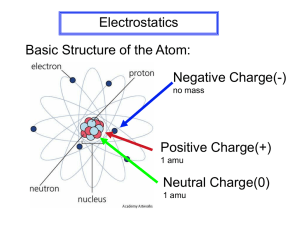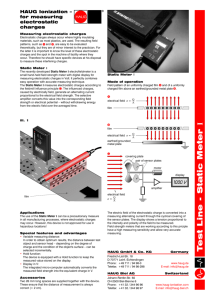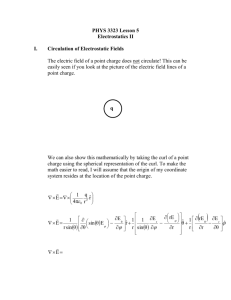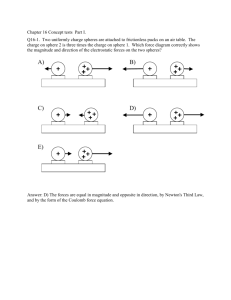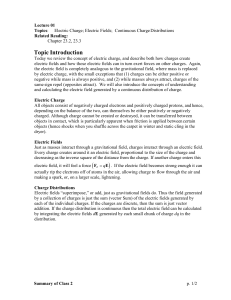Lecture 5. Electrostatic Potential Energy
advertisement
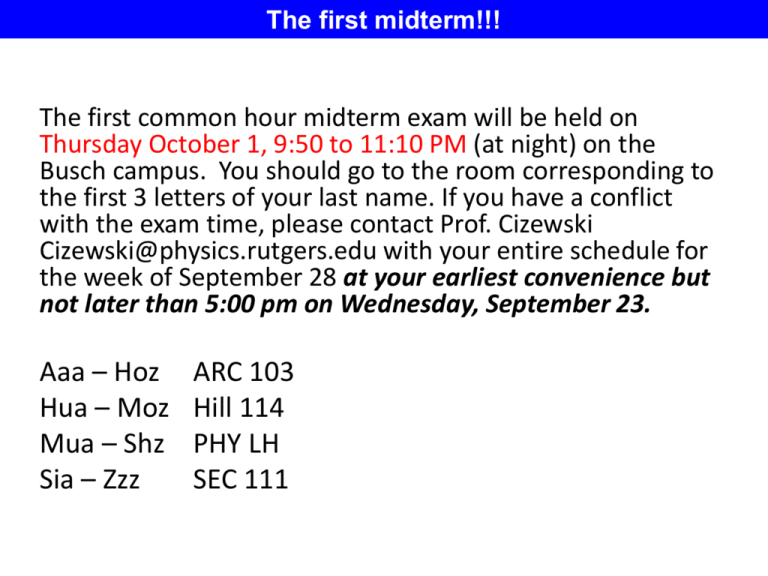
The first midterm!!! The first common hour midterm exam will be held on Thursday October 1, 9:50 to 11:10 PM (at night) on the Busch campus. You should go to the room corresponding to the first 3 letters of your last name. If you have a conflict with the exam time, please contact Prof. Cizewski Cizewski@physics.rutgers.edu with your entire schedule for the week of September 28 at your earliest convenience but not later than 5:00 pm on Wednesday, September 23. Aaa – Hoz Hua – Moz Mua – Shz Sia – Zzz ARC 103 Hill 114 PHY LH SEC 111 Iclicker Question A point charge +Q is placed inside a neutral, hollow, spherical conductor. As the charge is moved around inside, the electric field outside A. B. C. D. +Q is zero and does not change is non-zero but does not change is zero when centered but changes is non-zero and changes 2 Iclicker Question A point charge +Q is placed inside a neutral, hollow, spherical conductor. As the charge is moved around inside, the electric field outside A. B. C. D. +Q is zero and does not change is non-zero but does not change is zero when centered but changes is non-zero and changes 3 Lecture 5. Electrostatic Potential Energy This lecture is about forces and potential energy U(r), unit = joule, J Next lecture is about electrical potential V(r), unit: volt, V Don’t mix the two up. 𝑈 𝑟 𝑉 𝑟 = 𝑞 4 Lecture 5. Electrostatic Potential Energy Coulomb’s Law and Superposition Principle – sufficient to solve any electrostatic problem. Gauss’ Law simplifies calculation of electric fields for symmetric charge distributions. Why do we need anything else? 5 Lecture 5. Electrostatic Potential Energy Coulomb’s Law and Superposition Principle – sufficient to solve any electrostatic problem. Gauss’ Law simplifies calculation of electric fields for symmetric charge distributions. Why do we need anything else? Example Two charges q=+1C are 1 m apart at rest. We release the charges. What would be the net kinetic energy (in SI units) of the system when the charges are very far from one another? +1𝐶 +1𝐶 1𝑚 A. k1 B. -k1 C. k2 D. -k2 E. 0 6 Iclicker question Consider two concentric spherical metallic shells, one with radius R and one with radius 2R. Both have the same charge Q. At a point just inside the outer shell, the magnitude of the electric field is Q Q R 2R A. 𝟐𝒌𝑸/𝑹𝟐 B. 𝒌𝑸/𝑹2 C. 𝒌𝑸/𝟐𝑹𝟐 D. 𝟎 E. 𝒌𝑸/𝟒𝑹𝟐 7 Iclicker question Consider two concentric spherical metallic shells, one with radius R and one with radius 2R. Both have the same charge Q. At a point just inside the outer shell, the magnitude of the electric field is Q Q R 2R A. 𝟐𝒌𝑸/𝑹𝟐 B. 𝒌𝑸/𝑹2 C. 𝒌𝑸/𝟐𝑹𝟐 D. 𝟎 E. 𝒌𝑸/𝟒𝑹𝟐 8 Iclicker Question An insulating spherical shell of inner radius a and outer radius b is uniformly charged with a positive charge density. The radial component of the electric field, 𝑬𝒓 𝒓 , is best depicted by which figure? A B C D 9 Iclicker Question An insulating spherical shell of inner radius a and outer radius b is uniformly charged with a positive charge density. The radial component of the electric field, 𝑬𝒓 𝒓 , is best depicted by which figure? A B C D 10 Lecture 5. Electrostatic Potential Energy Coulomb’s Law and Superposition Principle – sufficient to solve any electrostatic problem. Gauss’ Law simplifies calculation of electric fields for symmetric charge distributions. Why do we need anything else? - Electrostatic forces are conservative, and energy conservation is a very powerful tool for solving a wide range of problems. - The concept of the potential energy of the electrostatic field is the first step towards the appreciation of the energy of electromagnetic field. 11 Recall: Potential Energy in Gravitational Field 𝑎 𝐹𝑔 𝐹𝑢𝑠 𝑏 Work done by us while lifting the body from a to b at constant speed: 𝑟 𝑏 𝑊𝑎→𝑏 "𝑢𝑠" = 𝑈 𝑟 𝐹𝑢𝑠 ∙ 𝑑𝑟 𝑎 𝑏 Work done by the grav. force Fg: 𝑊𝑎→𝑏 "𝑓𝑖𝑒𝑙𝑑" = 𝐹𝑔 ∙ 𝑑𝑟 𝑎 𝑏 ∆𝑈 𝑟 = 𝑊𝑎→𝑏 "𝑢𝑠" = 𝐹𝑢𝑠 ∙ 𝑑𝑙 Units: Joules, J 𝑎 Change in potential energy is equal to the work done by external forces (“us”) to move an object in gravitational field (assuming that kinetic energy remains constant). Potential energy: always the energy of interaction between masses, not a characteristic of a single mass (the potential energy of the system “Earth + mass m”). 12 Gravitational Potential Energy of the system “Earth + astronaut” 𝑎 𝐹𝑔 𝐹𝑢𝑠 𝑏 𝑟 Potential energy with respect to “” : 𝑟 𝑈 𝑟 −𝑈 ∞ = 𝑟 𝐹𝑢𝑠 ∙ 𝑑𝑟 = ∞ 𝐺 ∞ 𝑈 𝑟 𝑟2 𝑈+𝐾 𝐾 𝑟2 𝑚𝐸 𝑚 𝑟 ∙ 𝑑𝑟𝑟 = 𝑟2 𝑟1 𝑟 𝑚𝐸 𝑚 𝑚𝐸 𝑚 𝑑𝑟 = −𝐺 𝑟2 𝑟 𝐺 ∞ 𝑟 𝐾 𝑟1 = 0 𝑈 𝑟 + 𝐾 𝑟 = 𝑐𝑜𝑛𝑠𝑡 Energy conservation 13 Reference Point(s) 𝑟 𝑈 𝑟 = 𝐹𝑢𝑠 ∙ 𝑑𝑟 𝑠𝑜𝑚𝑒 𝑟𝑒𝑓.𝑝𝑜𝑖𝑛𝑡 Reference point: matter of convenience, only U matters (because only forces can be measured, and the forces depend on U, not U). 𝐹 𝑟 =− 𝜕𝑈 𝑟 𝑟 𝜕𝑟 “sea level” as a reference: 𝑈 𝑟 − 𝑈 𝑟𝐸 = −𝐺𝑚𝐸 𝑚 ≅ 𝐺𝑚𝐸 𝑚 𝑟 − 𝑟𝐸 𝐺𝑚𝐸 = 𝑚 ∆ℎ = 𝑚𝑔∆ℎ 𝑟𝐸 2 𝑟𝐸 2 ≡ 𝑟 − 𝑟𝐸 ≪ 𝑟𝐸 1 1 − 𝑟 𝑟𝐸 𝑔 U h mg h 14 Conservative Vector Fields Gravitational and Electrostatic Fields are conservative. The reason: both fields are central (a central force depends only on the distance between interacting objects and is directed along the line joining them). ∆𝑈 depends only on the initial and final points of the trajectory: 𝐹𝐸 ∙ 𝑑𝑙 = 0 - for any loop No closed E field lines in electrostatics: 15 Work in Electrostatic Field Consider two point charges, +𝑞1 and +𝑞2 . Place +𝑞1 at the origin. 𝑞2 𝑞1 r 𝐹𝑢𝑠 𝐹𝑢𝑠 𝑑𝑙 𝑞2 𝐸 𝑟 𝑞2 𝐸 𝑟 Let’s bring 𝑞2 from to () P at a distance r from the origin. The work done by us: 𝑟 𝑊∞→𝑟 "𝑢𝑠" = 𝑟 𝐹𝑢𝑠 ∙ 𝑑𝑙 = ∞ ∞ 1 𝑞1 𝑞2 𝑞1 𝑞2 1 1 𝑞1 𝑞2 1 − 𝑟 ∙ 𝑑𝑟 = − = 2 4𝜋𝜀0 𝑟 4𝜋𝜀0 𝑟 ∞ 4𝜋𝜀0 𝑟 along the green trajectory 𝑈 𝑟 We worked against the electrostatic forces and increased the potential energy of this charge distribution. ∝ 1/𝑟 r 16 Electrostatic Potential Energy 𝑟 𝑟 𝑈 𝑟 = 𝐹𝑢𝑠 ∙ 𝑑𝑙 = − 𝑠𝑜𝑚𝑒 𝑟𝑒𝑓.𝑝𝑜𝑖𝑛𝑡 - the potential energy of the system “charge 𝑞 + external electrostatic field 𝐸 𝑟 ” 𝑞𝐸 𝑟 ∙ 𝑑𝑙 𝑠𝑜𝑚𝑒 𝑟𝑒𝑓.𝑝𝑜𝑖𝑛𝑡 𝑞1 𝑞2 r ()P ()P 𝑈 𝑟 =− ()Q ()Q 𝑞2 𝐸1 𝑟 ∙ 𝑑𝑙 = − ∞ 𝑞1 𝐸2 𝑟 ∙ 𝑑𝑙 = ∞ 𝑈 𝑟 𝑈 𝑟 𝑞1 𝑞2 1 4𝜋𝜀0 𝑟 r 𝐸𝑡𝑜𝑡 = 𝐾 𝑟 + 𝑈 𝑟 ()P ++ or -- ()Q r +- or -+ 17 Iclicker Question Two charges q=+1C are 1 m apart at rest. We release the charges. What would be the net kinetic energy of the system when the charges are very far from one another? +1𝐶 +1𝐶 𝑘𝑞1 𝑞2 𝑈 𝑟 = 𝑟 1𝑚 A. k1 J B. -k1 J C. k2 J D. -k2 J E. 0 18 Iclicker Question Two charges q=+1C are 1 m apart at rest. We release the charges. What would be the net kinetic energy (in SI units) of the system when the charges are very far from one another? +1𝐶 +1𝐶 1𝑚 A. k1 B. -k1 C. k2 D. -k2 E. 0 19 Example 𝑒𝑛𝑑 ∆𝑈 𝑟 = − 𝑄𝐸 𝑟 ∙ 𝑑𝑙 𝑠𝑡𝑎𝑟𝑡 1,0 = −𝑄 1,−2 𝐸 𝑥, 𝑦 ∙ 𝑑𝑥 𝑥 + 0,0 𝐸 𝑥, 𝑦 ∙ 𝑑𝑦 𝑦 1,0 1,0 = −𝑄 1,−2 2𝑥 + 3𝑦 ∙ 𝑑𝑥 𝑥 + 0,0 2𝑥 + 3𝑦 ∙ 𝑑𝑦 𝑦 1,0 = +3 2 − 6 J = −12 J 20 From 𝑼 𝒓 to 𝑭 𝒓 𝑟 𝑈 𝑟 =− 𝐹 𝑟 ∙ 𝑑𝑙 One-dimensional case: 𝑟𝑒𝑓.𝑝𝑜𝑖𝑛𝑡 +𝑞 r ()P 𝑈 𝑟 −𝑞 ()Q r0 r 𝑑𝑈 𝑥 𝐹 𝑥 =− 𝑥 𝑑𝑥 𝑞1 𝑞2 1 𝑞2 𝑈 𝑟 = =− 4𝜋𝜀0 𝑟 4𝜋𝜀0 𝑟 𝐹 𝑟 =− 𝑑𝑈 𝑟 𝑟 𝑑𝑟 𝑑𝑈 𝑟 /𝑑𝑟 – positive, 𝐹 𝑟 is directed along −𝑟. (as it should be, because of attraction) Q: is it possible to find E(r) if we know U(r) only at this particular point? 21 Iclicker Question U(x) is shown on the plot: U(x) x Which plot shows the correct F(x) ? F(x) 𝑑𝑈 𝑥 𝐹 𝑥 =− 𝑥 𝑑𝑥 22 Iclicker Question U(x) is shown on the plot: U(x) x Which plot shows the correct F(x) ? F(x) 23 Choice of Reference Point The reference point can be any point. By shifting the reference point, we add the same constant values to the potential energies at all other points: 𝑈 𝑟 𝑟 𝑈 𝑟 =− r 𝑞𝐸 ∙ 𝑑𝑙 𝑟𝑟𝑒𝑓 This ambiguity shouldn’t bother us, because only the potential difference is meaningful (𝐹𝐸 𝑟 = − 𝑑𝑈 𝑟 𝑑𝑟 𝑟), and the difference doesn’t depend on the reference point. 𝑟 Localized (“finite”)charge distribution. The natural choice is to set U=0 at an infinitely distant point. Again, it’s just a matter of convenience. For many problems, it’s convenient to set the potential energy of charges on the “ground” to zero. O 𝑟𝑟𝑒𝑓 24 “Infinite” Charge Distributions - charge distribution that extends to infinity (e.g., a charged infinite plane). The choice of an infinitely distant reference point is inconvenient – all electrostatic energies would be infinitely large. The remedy is to choose less remote reference point. Example: uniformly charged plane. y Convenient reference point: any point within the plane (x=0). All points within the plane have the same 𝑈 (we can move the charge over the plane without doing any work). 𝟎, 𝟎 x 𝟎, 𝒚 𝑥,𝑦 𝒙, 𝒚 ∆𝑈 = 𝑈 𝑥, 𝑦 − 𝑈 0,0 = − 𝑞𝐸 𝑥 ∙ 𝑑𝑙 0,0 U(x) x =− 0,𝑦 𝑞𝐸 0,0 𝑥 ∙ 𝑑𝑦 − 𝑥,𝑦 𝑞𝐸 0,𝑦 𝜎 𝑥 ∙ 𝑑𝑥 = −𝑞 2𝜖 𝑥 0 25 Superposition: several interacting charges 𝑞2 𝑟02 𝑟01 𝑞1 𝑞3 If the test charge interacts with several charges, the potential energy of the interaction between the test charge and all other charges is an algebraic sum of 𝑈0𝑖 : 𝑟03 𝑞0 𝑈0 = Example: a positive test charge interacting with a dipole 𝑈0 = 𝑈0 1 𝑞0 𝑞1 𝑞0 𝑞2 𝑞0 𝑞3 𝑞0 + + = 4𝜋𝜀0 𝑟01 𝑟02 𝑟03 4𝜋𝜀0 𝑖 𝑞𝑖 𝑟0𝑖 𝑞0 𝑞1 1 𝑞0 𝑞2 1 𝑞0 𝑞 1 1 + = − 4𝜋𝜀0 𝑟01 4𝜋𝜀0 𝑟02 4𝜋𝜀0 𝑟1 𝑟2 +𝑞 𝑞0 −𝑞 𝑈0 𝑥 𝑥 26 Conclusion Conservative vector fields Potential energy. Electrostatic potential energy. Calculation of U for simple charge distributions. Next time: Lecture 6. Calculation of Electric Potentials §§ 23.3 - 23.5 27 Appendix I. Conservative Vector Fields Conservative vector fields: the work by the field on a “charge” depends only on the initial and final points of a trajectory, but not on the shape of the trajectory. Math involved: 𝑐𝑢𝑟𝑙 𝐸 𝑟 = 𝑐𝑢𝑟𝑙 𝑎 𝑟 = 0 𝑎 ∙ 𝑑𝑙 = 0 𝜕𝐸𝑦 𝜕𝐸𝑥 𝜕𝐸𝑧 𝜕𝐸𝑦 𝜕𝐸𝑥 𝜕𝐸𝑧 − 𝑥+ − 𝑦+ − 𝑧 𝜕𝑦 𝜕𝑧 𝜕𝑧 𝜕𝑥 𝜕𝑥 𝜕𝑦 - circulation of a vector field - looks scary… But we can tell at a glance if the curl is zero or not: think of a vector field as a water flow and place a paddle wheel at the point in question. If the wheel rotates, the curl is non-zero. 𝑦 𝑦 𝑎 𝑥, 𝑦 = 𝑦𝑦 𝑥 𝜕𝐸𝑦 𝜕𝐸𝑦 = =0 𝜕𝑧 𝜕𝑥 𝑐𝑢𝑟𝑙 𝑎 𝑟 = 0 𝑎 𝑥, 𝑦 = 𝑥𝑦 𝑥 𝜕𝐸𝑦 =1 𝜕𝑥 𝑐𝑢𝑟𝑙 𝑎 𝑟 ≠ 0 28 Appendix II: Total energy of interactions between several charges 𝑞2 𝑟02 The total work required to assemble this charge distribution: 𝑟12 𝑞0 𝑞1 𝑈Σ = 𝑟03 𝑟13 𝑞3 𝑞0 𝑞1 1 𝑞0 𝑞2 1 𝑞1 𝑞2 1 1 + + +⋯= 4𝜋𝜀0 𝑟01 4𝜋𝜀0 𝑟02 4𝜋𝜀0 𝑟12 4𝜋𝜀0 𝑖<𝑗 𝑞𝑖 𝑞𝑗 𝑟𝑖𝑗 - all possible pairs, but each pair we count just once. Example: four equal charges in the corners of a square. 𝑞 𝑎 𝑞 𝑎 𝑞 𝑞 𝑈𝑒 𝑡𝑜𝑡𝑎𝑙 𝑞𝑖 𝑞𝑗 𝑞2 𝑞2 = =4 +2 4𝜋𝜖0 𝑟𝑖𝑗 4𝜋𝜖0 𝑎 4𝜋𝜖0 𝑎 2 𝑎𝑙𝑙 𝑝𝑎𝑖𝑟𝑠 each pair counts only once The energy is positive (the charges repel each other), the system can do some work if we let the charges go. On the other hand, the potential energy of one of these charges in the field due to the other three charges: 𝑞2 𝑞2 𝑈𝑒 = 2 + 4𝜋𝜖0 𝑎 4𝜋𝜖0 𝑎 2 29

